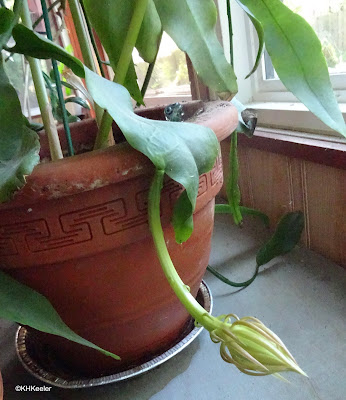"Here, wouldn't you like this?" my friend said, "it has a nice flower," and handed me a potted plant. It looked rather like a Christmas cactus, with no particular spines, but was much bigger than a Christmas cactus, with some of the parts long and narrow, others broad and flat.
 |
| Epiphyllum oxypetalum |
"Okay," I said, since I was always a sucker for a plant, especially one I knew nothing about. It came with its name on a handmade pot label, Epiphyllum oxypetalum. What a mouthful. I ignored the name.
 |
| Broad Epiphyllum oxypetalum cladode |
 |
| Awkward, unbalanced Epiphyllum plant, after I cut several long thin cladodes off of it |
Epiphyllum is a cactus (that is, in the cactus family Cactaceae). Its greeen parts are stems, called cladodes, not leaves. A key to recognizing modified stems is that leaves and other stems grow from stems, while leaves are terminal, no other part grows from them. This plant put out long thin cladodes-- looking for good light I presume--and made big broad ones--probably when they liked the light regime. The broad cladodes are up to 12" x 3", the long one you see in the photo is over 5'' long. The plant has had no problem making longer stems. (For scale, the interior diameter of the flowerpot above is 5").
They grew and became harder to manage. Long cladodes with big broad ones on the end and then a thin one going several feet more...they unbalanced the pot (note the rock in the saucer above!), sagged and slumped all over neighboring plants. Then they climbed the window and into the curtains.
I wasn't pleased, but I tried to tame them, not very successfully. I gave one away. For the summer, I put one on my closed porch, which becomes quite warm in the bright sun of summer afternoons. It reached to the ceiling, bent around the other plants. I put my other Epiphyllum pot in a north-facing upstairs window and let it cope with indirect sunlight and the 70-75 degree temperatures of my office.
In August 2020, on the porch watering my plants--wow! there was a bud on the Epiphyllum!
 |
| Epiphyllum bud, August 8, 2020 |
 |
| Epiphyllum oxypetalum flower See my wrist and watch band for scale. |
 |
| Small Epiphyllum bud, August 9, 2022 |
 |
| Epiphyllum oxypetalum buds on August 16, 2022 |
They opened after dark on August 17
I will treat my queens of the night with more respect, now I have seen and smelled their blossoms.
Queen of the night is native to Mexico south into South America. In nature, it usually grows epiphytically, that is, on another plant but getting water from the rain and nutrients from run off or stuff that accumulates around its base, not from the supporting plant. So living in the pots in my windows, my queens of the night grow like they would in nature, reaching with their cladodes for the best spots, even if the jade plant already was there. Its just that they are so BIG! On a tall tropical tree 5' stems are no big deal, in my window they are very awkward.
The name Epiphyllum is from the Greek, epi "upon" and phyllon "leaf", referring to the way the flowers come out of the broad cladodes which, at the time the plant was named (early 1800s) were thought to be leaves. The species epithet oxypetalum means "sharp-petaled" meaning they are sharply pointed.Dutchman's pipe cactus refers to the hooked shape of the buds and flowers.
Queen of the night is reportedly the most widely grown cactus, which is saying something considering the number of Christmas/holiday (Schlumbergera) cactuses in people's houses. They can be grown outdoors in USDA Zones 10 and 11...they will survive only a very light frost. They are jungle rather than desert plants, liking humidity and regular water. My house is dry and cool...since they flowered for me, they are pretty tolerant.
In nature, the big flowers are pollinated by bats, which must be grand to watch. They produce a pod that is edible.
Wonderful plants, but so difficult to keep from tipping over their flowerpots.
 |
| Upstairs queen of the night in her window. |


I’m so glad I found your post on the Queen of the Night . We have had one for a long time but never knew what it was or anything. Used google picture search to find out the name. Ours hasn’t been looking so good for years now. I never brought it in during winter either 😳. I’m in South Carolina. Anything other great tips on how to get our plant back in tip top shape would be greatly welcomed and appreciated. Thanks- Allison from S.C.
ReplyDeleteClick here to learn more about how to properly care for and prune your Epiphyllum oxypetalum. It's fascinating to read about the various stages of growth and challenges of managing this unique plant. The detailed experience shared here offers great insights into handling its growth and achieving beautiful blooms. I enjoyed reading about the transformation and care tips for this extraordinary cactus!
ReplyDeleteCool
ReplyDelete